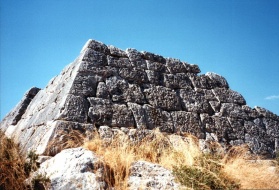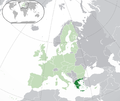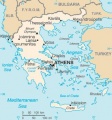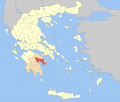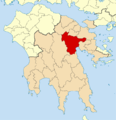Piramidi greche
Da Ufopedia.
| Questa voce ha bisogno di essere tradotta. |
Greek pyramids, also known as the Pyramids of Argolis, refers to several structures located in the plain of Argolid, Greece. The best known of these is known as the Pyramid of Hellinikon. In the time of Pausanias it was considered to be a tomb. Twentieth century researchers have suggested other possible uses.[1]
Indice |
Location
Writing in the 2nd century AD the geographer Pausanius mentions two buildings resembling pyramids, one, twelve miles southwest of the still standing structure at Hellenikon (Ελληνικό in Greek),[2] a common tomb for soldiers who died in a legendary struggle for the throne of Argos and another which he was told was the tomb of Argives killed in a battle around 669/8 BC. Neither of these still survive and there is no evidence that they resembled Egyptian pyramids.
There are also at least two surviving pyramid-like structures still available to study, one at Hellenikon and the other at Ligourio/Ligurio, a village near the ancient theatre Epidaurus. At the Southeastern edge of the plain of Argolid, near the springs of the Erasinos river (nowadays Kephalari) and on the main arterial road which in antiquity led from Argos to Tegea and the rest of Arcadia and Kynouria, there is a small structure extant known as the Pyramid of Hellenikon.
Historical references
Although the pyramid structures of Argolis are of great interest, written references are rather scarce and they are not mentioned in ancient sources.s ignored. She argues that they undertook their research using a novel, previously untested methodology in order to confirm a predetermined theory about the age of these structures.[3] Pausanias (2nd century AD) mentions two buildings resembling pyramids, one, twelve miles southwest of the still standing structure at Hellinikon,[4] a common tomb for soldiers who died in a legendary struggle for the throne of Argos and another which he was told was the tomb of Argives killed in a battle around 669/8 BC. Neither of these still survive.
On the way from Argos to Epidauria there is on the right a building made very like a pyramid, and on it in relief are wrought shields of the Argive shape. Here took place a fight for the throne between Proetus and Acrisius; the contest, they say, ended in a draw, and a reconciliation resulted afterwards, as neither could gain a decisive victory. The story is that they and their hosts were armed with shields, which were first used in this battle. For those that fell on either side was built here a common tomb, as they were fellow citizens and kinsmen.[5]
Excavations and dating
The pyramidal in Hellenikon was excavated first by Wiegand,[6] who essentially removed all the fill from the floor. Later on in 1937, more excavation was made by the American School of Archaeology at Athens under the direction of L. Lord who concluded that both the structure at Ligurio and the one at Cephalaria were "guard houses capable of accommodating a small garrison who could contiol the countryside and be safe behind their walls from surprise attacks by a few persons." [7] Amongst the findings are a large pithos, the floor of the long corridor and the room, re-carved from repairs entrance door and parts of the wall, infill from earlier excavations, some ceramics of Protohelladic II period (2800–2500 BC.) were attributed by S. Wienberg a member of the team, their location and distribution however is not described clearly,[8] also room foundations and mortars from later uses of the building, as well as, mixture disturbed sediments with ceramics of classical period (lamps, house ware), and few coarse sherds of doubtful age and some roman lamps. The infill at the floor varies between 20–60 cm.
The pyramidal in Hellenikon was excavated first by Wiegand,[9] who essentially removed all the fill from the floor. Later on in 1937, more excavation was made by the American School of Archaeology at Athens under the direction of L. Lord who concluded that both the structure at Ligurio and the one at Cephalaria were "guard houses capable of accommodating a small garrison who could contiol the countryside and be safe behind their walls from surprise attacks by a few persons." [10] Amongst the findings are a large pithos, the floor of the long corridor and the room, re-carved from repairs entrance door and parts of the wall, infill from earlier excavations, some ceramics of Protohelladic II period (2800–2500 BC.) were attributed by S. Wienberg a member of the team, their location and distribution however is not described clearly,[11] also room foundations and mortars from later uses of the building, as well as, mixture disturbed sediments with ceramics of classical period (lamps, house ware), and few coarse sherds of doubtful age and some roman lamps. The infill at the floor varies between 20–60 cm.
There is considerable controversy about the dates of these structures, with conflict between dating based on archeological excavations and dating through what was at the time the new technique of thermoluminescence dating, Ioannis Liritzis and his team argue for an early date through five sub-projects: 1) geophysical prospection inside and around the two pyramidals at Hellenikon and Ligourio, where buried monuments were discovered,[12] 2) these results directed the archaeological excavations carried out by archaeologist A.Sampson and archaeologists of the Archaeological Museum of Nauplion. Amongst the new finds were foundations of rooms, ceramics of Classical, Hellenistic, Roman and Protochristian periods, and protohelladic II in the exterior foundations of Hellenikon above the bedrock. A comparative study of masonries was also made,[13][14] 3) astronomical orientation of the long entrance corridor was found related to the rise of Orion’s belt occurring in c.2000-2400 BC.,[15] 4) the dating of some parts of the overlied large megalithic blocks in the wall, with the novel thermoluminescence dating method of rock surfaces. Sampling was chosen for their firmness and lack of sun exposure of internal contact surfaces, by removing a few milligrams of powder from pieces in firm contact. Seven pieces gave an age range of c. 2000–2500 BC.,[16][17].,[18] while two ceramic sherds of non-diagnostic typology one from Hellenikon and one from Ligourio dated by TL and OSL gave concordant ages of 3000±250 BC and 660±200 BC respectively.[19]
Mary Lefkowitz has criticised this research. She suggests that some of the research was done not to determine the reliability of the dating method, as was suggested, but to back up an assumption of age and to make certain points about pyramids and Greek civilization. She notes that not only are the results not very precise, but that other structures mentioned in the research are not in fact pyramids, e.g. a tomb alleged to be the tomb of Amphion and Zethus near Thebes, a structure at Stylidha (Thessaly) which is just a long wall, etc. She also notes the possibility that the stones that were dated might have been recycled from earlier constructions. She also notes that earlier research from the 1930s, confirmed in the 1980s by Fracchia, was ignored. She argues that they undertook their research using a novel, previously untested methodology in order to confirm a predetermined theory about the age of these structures.,[20]
Liritzis responded in a journal article published in 2011, stating that Lefkowitz failed to understand and misinterpreted the methodology.[21]
A. Sampson wrote that it was "already proved that the monument stood on Protohelladic constructions, therefore it was built in a later time. Besides, the masonry of the pyramid, similar to that of Ligourio, leads us to the Classic or Late Classic years. A new method for dating the stone, recently applied to the pyramids, indicated a too early dating in the 4th and 3rd millenium BC, which of course cannot be accepted. .[22]
The objection of an early age of some archaeologists (which though lacks of proper publication apart of the original excavation reports) is understood and this is the case with any megalithic structures used by later people that may have been subjected to considerable repairs. Such strong structures are bound to have been re-used and the findings do not necessarily represent the initial construction. Until newer scientific evidence is produced at present the early age of these pyramidals is not excluded.
Galleria immagini
References
- ↑ Louis E. Lord, Watchtowers and Fortresses in Argolis, American Journal of Archaeology, Vol. 43, No. 1 (January - March, 1939), pp. 78-84 [1]
- ↑ Template:Cite book
- ↑ Template:Cite book
- ↑ Template:Cite book
- ↑ Pausanias, Description of Greece 2:25
- ↑ Wiegand, T 1901, Die pyramide von Kenchreai. Athen. Mitteilungen, xxvi, 341-246
- ↑ Lord, L, 1938. The "Pyramids" of Argolid. Hesperia, vii, 4, 481-538
- ↑ Lord, p.508, 538
- ↑ Wiegand, T 1901, Die pyramide von Kenchreai. Athen. Mitteilungen, xxvi, 341-246
- ↑ Lord, L, 1938. The "Pyramids" of Argolid. Hesperia, vii, 4, 481-538
- ↑ Lord, p.508, 538
- ↑ Theocaris P., Liritzis I., Lagios E., and Sampson A. (1997. Geophysical prospection and archaeological test excavation and dating in two Hellenic pyramids. Surveys in Geophysics, 17, 593-618
- ↑ Liritzis, Ι 1998 The mystery of the Hellenic pyramidals, Athens, in Greek with English summary
- ↑ Theocaris P., Liritzis I., Lagios E., and Sampson A. (1997) Geophysical prospection and archaeological test excavation and dating in two Hellenic pyramids. Surveys in Geophysics, 17, 593-618
- ↑ Liritzis I. 1998. Bronze Age Greek Pyramids and Orion's belt. Griffith Observer, vol.63, n.10, 10-21
- ↑ Liritzis,Ι. 1994 A new dating method by thermoluminescence of carved megalithic stone building. Comptes Rendus (Academie des Sciences), Paris, t. 319, serie II, 603-610
- ↑ Liritzis.I (1994) Archaeometry: Dating the past. EKISTICS, t.368/364, 361-366
- ↑ Theocaris P.S., Liritzis I. and Galloway R.B. (1994). Dating of two Hellenic pyramids by a novel application of thermoluminescence. J. Archaeological Science, 24, 399-405
- ↑ Liritzis I., Galloway R.B. and Theocaris P. 1994 Thermoluminescence dating of ceramics revisited: Optical stimulated luminesccence of quartz single aliquot with green light emitting diodes. J. Radioanal. Nucl. Chem. Letters, 188 (3), 189-198
- ↑ Template:Cite book
- ↑ Liritzis Ioannis, "Surface dating by luminescence: An Overview" GEOCHRONOMETRIA 38(3) 292-302, June issue, http://www.springer.com/alert/urltracking.do?id=L1a5692M7cfc5eSae2cd93
- ↑ Sampson, A 1996. The pyramids of Argolid and their meaning. Archaeology, t.57, 56-61, in Greek
Sources
- Theodore Wiegand, Monograph of 1901.
- Louis E. Lord, The "Pyramids" of Argolis, Hesperia, Vol. 7, No. 4 (1938), pp. 481–527, doi:10.2307/146570, [2].
- Louis E. Lord, M. Alison Frantz, Carl Roebuck, Blockhouses in the Argolid, Hesperia, Vol. 10, No. 2 (Apr. - Jun., 1941), pp. 93–112 doi:10.2307/146534 [3].
